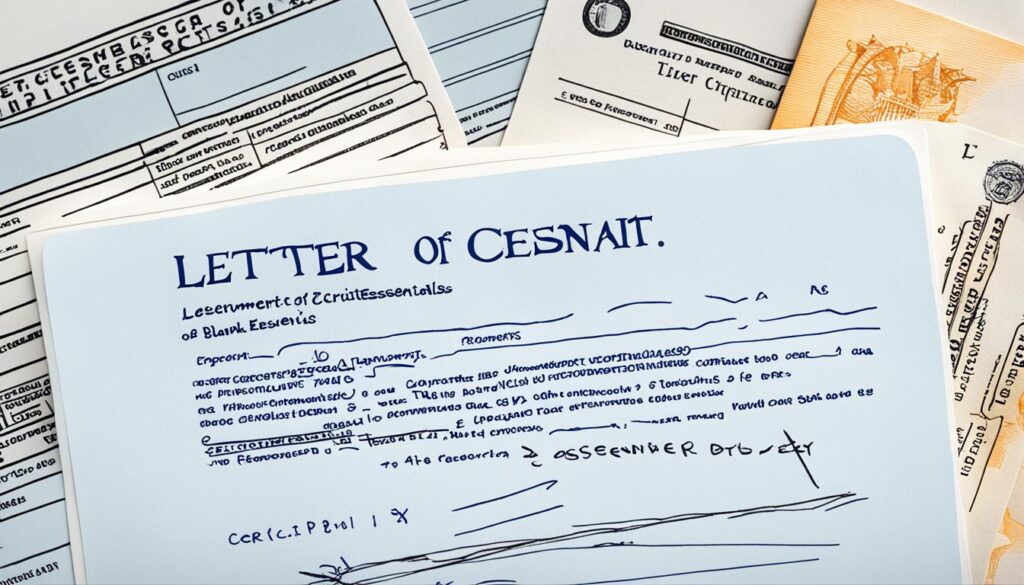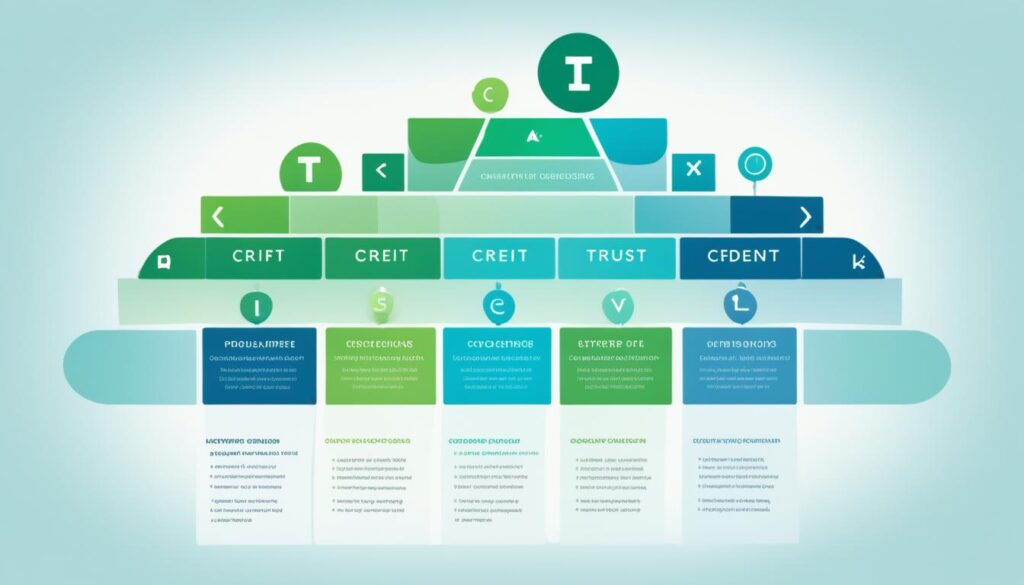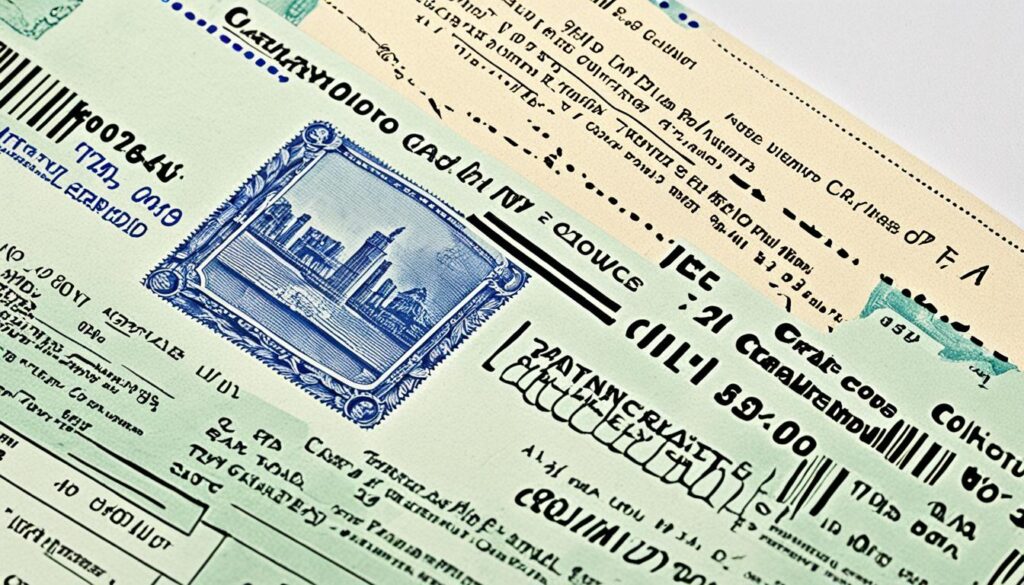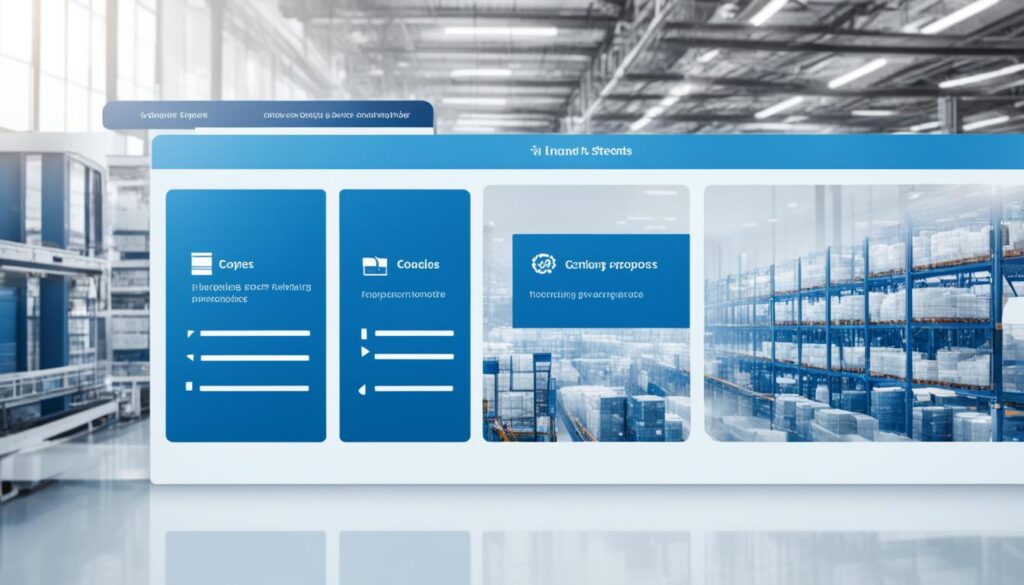Are you involved in international trade and want to secure your transactions? Discover how a letter of credit (LC) can provide a reliable mechanism for secure and efficient payment transactions.
International trade involves various risks, including the risk of non-payment. So, how can you ensure that you will be paid for your goods or services? The answer lies in understanding the essentials of a letter of credit and how it can benefit your business.
Let’s dive into the world of trade finance and explore the key components, types, process, and benefits of a letter of credit. Whether you’re an exporter or an importer, this comprehensive guide will empower you to conduct international transactions with confidence.
Key Takeaways:
- A letter of credit (LC) is a crucial trade finance document that acts as a contractual commitment from a bank to make payment to a beneficiary once certain conditions are met.
- LCs provide numerous benefits, including reducing the risk of non-payment and improving cash flow management.
- There are various types of LCs available, such as Sight LC, Usance LC, Back-to-Back LC, and more, each tailored to meet different trade scenarios.
- The LC process involves the issuing bank, buyer, beneficiary, and advising bank, among other parties.
- Understanding the essentials of a letter of credit is essential for smooth international transactions and mitigating risks in trade finance.
What is a Letter of Credit (LC)?
A Letter of Credit (LC) is a crucial trade finance tool that acts as a contractual commitment from a bank to make payment to a beneficiary on behalf of the buyer once certain conditions are met. It guarantees that the buyer’s bank will pay the exporter upon completion of the agreed-upon terms. The LC outlines the specific requirements for the export transaction, such as the amount, documents needed for payment, and the expiration date. It provides a reliable mechanism for secure and efficient payment transactions in international trade.
Understanding the concept and structure of a letter of credit is essential for businesses engaged in international trade. With an LC in place, both the buyer and exporter can have confidence in the security and payment guarantee provided by the involved banks. The use of LCs simplifies trade finance by establishing clear terms and conditions that must be met before payment is released. This ensures that both parties fulfill their obligations and reduces the risk of non-payment, benefiting the global trade community as a whole.
“The use of letters of credit in international trade provides a payment guarantee that protects the interests of both the buyer and seller while facilitating smoother transactions.”
| Benefits of a Letter of Credit (LC) | Key Components |
|---|---|
|
|
By utilizing letters of credit, businesses can confidently engage in cross-border transactions, knowing that payment is guaranteed upon compliance with the LC terms. This not only minimizes risks but also enhances cash flow management, allowing for better financial planning and execution of international trade activities.
Example:
Let’s say a company in the United States wants to import goods from a supplier in Japan. To ensure secure payment for the goods and mitigate the risk of non-payment, the buyer’s bank issues a letter of credit guaranteeing payment to the exporter once the required documents are presented. The exporter then ships the goods and submits the necessary documentation to the advising bank. Upon verification, the advising bank releases the payment to the exporter, completing the transaction.
In this scenario, the letter of credit serves as a payment guarantee, giving confidence to both the buyer and the exporter. It ensures that payment will be made only when all the terms and conditions outlined in the LC are met, creating a secure and reliable trade environment.
Key Components and Parties Involved in a Letter of Credit
A Letter of Credit (LC) is a complex trade finance instrument that involves several key components and parties. Understanding the roles and responsibilities of each party is essential for a smooth LC transaction. Let’s take a closer look at the main components:
1. Issuing Bank:
The issuing bank plays a crucial role in the LC process. They are responsible for issuing the LC, which serves as a guarantee of payment to the beneficiary. The issuing bank ensures that the conditions specified in the LC are met before making the payment to the beneficiary. They act as the financial intermediary between the buyer and the beneficiary.
2. Buyer/Applicant:
The buyer, also known as the applicant, is the party who initiates the LC and requests the issuing bank to issue it. The buyer provides the necessary instructions and requirements for the LC, such as the amount, expiry date, and specific terms and conditions.
3. Beneficiary:
The beneficiary is the party to whom the payment is made under the LC. Usually, the beneficiary is the exporter or seller of goods or services. Upon fulfilling the terms and conditions specified in the LC, the beneficiary can receive payment from the issuing bank.
4. Advising Bank/Confirming Bank:
The advising bank, also referred to as the confirming bank, plays a crucial role in the LC process. They authenticate the LC and advise the beneficiary on its terms and conditions. The advising bank also verifies the authenticity of the LC and ensures that the beneficiary understands and complies with its requirements.
5. Expiry Date:
The expiry date is an important component of the LC. It specifies the date until which the LC is valid. Any presentation of documents or requests for payment made after the expiry date may be considered invalid, and the beneficiary may not receive payment.
6. Documentary Requirements:
The LC outlines the specific documents needed for payment, which may include invoices, bills of lading, certificates of origin, inspection certificates, and other relevant documents. These documents provide evidence that the goods or services have been delivered as per the agreed-upon terms.
Understanding these key components and parties involved in a Letter of Credit is crucial for successful trade finance transactions. With clear roles and responsibilities, the LC process can be executed effectively, ensuring secure payment and reducing the risk for both buyers and beneficiaries.

Practical Uses and Benefits of LC in International Trade
A Letter of Credit (LC) is an invaluable tool in international trade. It plays a pivotal role in mitigating the risk of non-payment, ensuring secure and efficient payment transactions. By providing a guarantee of payment, LCs give exporters confidence that they will be paid once the agreed-upon conditions are met.
One of the key benefits of utilizing LCs is the enhanced risk mitigation they offer. Exporters are shielded from the potential non-payment by the buyer, as the LC provides a financial commitment from the buyer’s bank. This assurance enables exporters to expand their reach to new markets, increase their customer base, and grow their businesses globally.
Furthermore, LCs facilitate cash flow management for both exporters and importers. Exporters can receive prompt payment by presenting the required documents to the bank, ensuring a steady cash flow. On the other hand, importers can negotiate delayed payment terms, allowing them to manage their finances more effectively and optimize their working capital.
“A Letter of Credit mitigates the risk of non-payment, ensures secure cash flow, and encourages international trade.”

Another advantage of LCs is their versatility and flexibility to adapt to various trade scenarios. LCs can be tailored to accommodate specific requirements, matching the unique needs of different parties involved in international transactions.
Here’s an example to illustrate the practical use of an LC:
“Exporter A wants to ship goods to Importer B in a foreign country. To ensure secure payment, Exporter A requests an LC from Importer B, who then arranges for their bank to issue the LC in favor of Exporter A. The LC specifies the conditions that must be met for payment to be made. Once Exporter A complies with the terms and presents the required documents to the bank, payment is released.”
By embracing the advantages of LCs, businesses can engage in international transactions with greater confidence, minimize risks, and promote economic growth through global trade.
Types of Letters of Credit: An Overview
In international trade, different types of Letters of Credit (LCs) serve specific purposes. Understanding these variations is essential for businesses involved in trade finance. Here are some of the commonly used types of LCs:
- Sight LC: This type of LC offers immediate payment to the exporter once the required documents are presented. It ensures prompt transaction completion and is suitable for sellers who prefer immediate payment upon shipment completion.
- Usance LC: Usance LC provides deferred payment terms, allowing the importer to delay payment until a specified date after the documents have been presented. This type of LC provides financial flexibility to buyers and allows them to manage their cash flow effectively.
- Back-to-Back LC: Back-to-Back LCs are used when multiple parties are involved in a trade transaction. In this scenario, the buyer’s bank issues an LC based on an existing LC already received by the buyer from another bank. This type of LC eliminates the need for the buyer to involve additional banks.
These examples represent just a fraction of the diverse range of LC types available to businesses engaged in international trade. Each type caters to specific trade requirements and offers unique features and benefits. Understanding the options enables businesses to choose the most suitable LC type for their trade transactions, ensuring a smooth and secure trade finance experience.
Source:
If the buyer prefers immediate payment upon completion of shipment, a Sight LC is the most appropriate choice. On the other hand, if the buyer wants to defer the payment for a specific period, the Usance LC allows them to do so. Additionally, if multiple parties are involved in a trade, a Back-to-Back LC simplifies the process by eliminating the need for additional banks.

| LC Type | Payment Method | Beneficiary | Benefit |
|---|---|---|---|
| Sight LC | Immediate payment upon document presentation | Exporter | Fast and secure payment |
| Usance LC | Deferred payment terms | Importer | Cash flow management |
| Back-to-Back LC | Used when multiple parties are involved | Exporter, importer | Streamlined trade transaction |
A Closer Look at the Process: How a Letter of Credit Works
Understanding the process of how a Letter of Credit (LC) works is essential for businesses involved in trade finance. Let’s examine the key steps involved:
1. Issuance of the LC by the Buyer’s Bank
It all begins with the buyer’s bank issuing the LC, which outlines the specific requirements for the export transaction. This includes details such as the payment amount, expiry date, and the documents needed for payment.
2. Shipment of Goods
Once the LC is in place, the exporter can proceed with shipping the goods to the buyer.
3. Presentation of Required Documents to the Buyer’s Bank
Once the goods are shipped, the exporter presents the required documents to the buyer’s bank. These documents typically include the commercial invoice, bill of lading, packing list, and any additional documents specified in the LC.
4. Examination of Documents
The buyer’s bank carefully examines the presented documents to ensure they comply with the terms and conditions outlined in the LC. This includes verifying the accuracy and authenticity of the documents.
5. Payment to the Exporter
If all the documents are in order, the buyer’s bank will proceed with making the payment to the exporter. This payment can either be made immediately or based on the agreed-upon terms within the LC.
It’s important to note that compliance with the LC terms and attention to detail are crucial for a smooth payment process. Any discrepancies or inaccuracies in the documents can lead to delays in the payment or even non-payment.

The LC process simplifies international trade transactions by providing a secure and reliable payment mechanism. Both buyers and sellers can have confidence in the transaction, knowing that payment will be made once the agreed-upon conditions are met.
Now that we have delved into the process of how a Letter of Credit works, let’s explore the potential risks and challenges associated with using LCs in the next section.
Potential Risks and Challenges with Using LC
While a letter of credit (LC) is a valuable tool in trade finance, it is not without its potential risks and challenges. One of the main risks is the potential for discrepancies in the required documents, which can lead to delays or non-payment. The complexity and stringent regulations associated with LCs can also pose challenges, requiring precision and attention to detail. Additionally, there may be certain costs associated with LCs, such as issuance fees and confirmation fees. Businesses need to be aware of these risks and challenges and work with trusted professionals to navigate the process effectively.
Document Discrepancies
One major challenge with using LCs is the risk of discrepancies in the required documents. The LC sets out specific conditions that must be met for payment to be made. Any inconsistency or error in the presented documents can result in delays or even rejection of payment. For example, if the bill of lading does not match the description of the goods in the LC, the bank may not release the payment. Exporters must ensure strict compliance with the LC terms and carefully review all documents before submission.
Complexity and Stringent Regulations
The process of utilizing LCs involves navigating complex regulations and procedures. There are strict rules and guidelines that must be followed to ensure smooth transactions. From selecting the appropriate type of LC to fulfilling documentary requirements, businesses must have a thorough understanding of the process to avoid potential pitfalls. Non-compliance with regulations can lead to payment delays and additional costs.
Costs Associated with LCs
While LCs offer security and payment guarantees, there are costs associated with their use. These costs may include issuance fees, confirmation fees, and negotiation fees. It’s essential for businesses to factor in these costs when planning their trade finance strategies. Working with experienced professionals in LC transactions can help businesses navigate the fee structure and make informed financial decisions.
Navigating Risks and Challenges with Expert Guidance
To successfully manage the risks and challenges associated with LCs, it is crucial for businesses to work with trusted professionals who specialize in trade finance. These experts can provide valuable guidance and assistance in navigating the complexities of LC transactions, ensuring compliance with regulations, and minimizing the risk of errors or discrepancies that could impact payment.
How to Apply for a Letter of Credit
To apply for a letter of credit (LC), businesses need to follow a straightforward process. Here are the steps to successfully apply for an LC:
- Contact your bank: Reach out to your bank’s international trade department or commercial division to initiate the LC application process.
- Gather necessary details: Gather all the relevant information about the trade deal, including the goods or services being exchanged, the payment amount, and the expected delivery date. This information is crucial for the LC application.
- Review requirements: Carefully review all the application requirements provided by your bank. Make sure you understand each requirement and gather the necessary supporting documents.
- Complete the application: Fill out the LC application form provided by your bank. Provide accurate and detailed information to avoid any delays or issues during the assessment process.
- Submit the application: Ensure timely submission of your application to the bank. Pay attention to any specified deadlines to expedite the processing of your LC application.
Once you have submitted your LC application, the bank will assess your eligibility based on your business’s assets or creditworthiness. It’s important to provide complete and accurate information to increase your chances of a successful application. Working closely with your bank and providing any additional requested documentation promptly can also expedite the process.
Applying for an LC requires attention to detail and understanding of the specific documents needed. By following the proper steps and working closely with your bank, you can navigate the application process smoothly and secure the letter of credit necessary to facilitate your trade transactions.

“Applying for a letter of credit involves gathering all the necessary details and carefully reviewing the requirements. Timely submission and accurate information are key to a successful LC application.” – [Your Name], Trade Finance Expert
Costs Associated with a Letter of Credit
When it comes to utilizing a letter of credit (LC) for trade finance, it’s important to take into account the costs involved. Along with the security and convenience provided by an LC, there are fees associated with its issuance and management. Understanding these costs can help businesses plan their trade finance strategies effectively.
Issuance Fees
One of the primary costs associated with an LC is the issuance fee. This fee is charged by the bank issuing the LC and covers the administrative costs of preparing and processing the necessary documents. Issuance fees can vary based on the complexity and value of the trade transaction.
Confirmation Fees
In certain cases, the LC may also require confirmation by a confirming bank. This additional layer of assurance to the beneficiary incurs confirmation fees. The confirming bank charges this fee for guaranteeing payment upon the fulfillment of the LC terms and conditions.
Negotiation Fees
When the beneficiary submits the required documents to the bank, they may charge negotiation fees for reviewing and processing the documents. These fees cover the administrative tasks involved in assessing the documents’ compliance with the LC requirements.
It’s crucial for businesses to be aware of these costs upfront and include them in their trade finance calculations. Working with professionals experienced in LC transactions can provide valuable guidance on navigating the fee structure and ensuring a thorough understanding of the financial implications involved.
Important Terminology in Letter of Credit Transactions
Letter of credit (LC) transactions involve various terms and concepts that are important to understand. By familiarizing ourselves with the terminology, we can effectively communicate and navigate the complexities of LC transactions. Here are some key terms to know:
1. Issuing Bank
The issuing bank is the financial institution that issues the letter of credit on behalf of the buyer (applicant). It provides a payment guarantee to the beneficiary (seller) upon meeting the stipulated conditions.
2. Applicant/Buyer
The applicant, also known as the buyer, is the party who requests the issuing bank to issue the LC. The buyer is responsible for reimbursing the issuing bank for any payments made to the seller.
3. Beneficiary/Seller
The beneficiary, also known as the seller, is the party who will receive payment under the LC. The seller must fulfill the agreed-upon terms and conditions to claim payment.
4. Advising Bank
The advising bank, also referred to as the notifying bank, is the bank that authenticates the LC and advises the beneficiary on its terms and conditions. It acts as an intermediary between the issuing bank and the beneficiary.
5. Confirming Bank
In some cases, the advising bank may also serve as a confirming bank. A confirming bank adds its confirmation to the LC, guaranteeing payment to the beneficiary regardless of the issuing bank’s ability to pay. This provides an additional layer of security for the seller.
6. Drawee Bank
The drawee bank is the bank on which the LC is drawn. It is typically the issuing bank or another bank designated by the issuing bank. The drawee bank makes the payment to the beneficiary upon presentation of compliant documents.
| Term | Definition |
|---|---|
| Issuing Bank | The bank that issues the LC on behalf of the buyer. |
| Applicant/Buyer | The party who requests the LC and is responsible for reimbursing the issuing bank. |
| Beneficiary/Seller | The party who receives payment under the LC. |
| Advising Bank | The bank that authenticates the LC and advises the beneficiary. |
| Confirming Bank | The bank that adds its confirmation to the LC, providing an additional layer of security for the seller. |
| Drawee Bank | The bank on which the LC is drawn, responsible for making the payment to the beneficiary. |
Understanding these important terms and their roles in LC transactions is essential for effective participation in trade finance. Now, let’s explore the process and benefits of using LCs.
Conclusion
Understanding the essentials of a letter of credit (LC) is crucial for businesses involved in international trade. An LC provides a reliable mechanism for secure and efficient payment transactions, reducing the risk of non-payment and improving cash flow management. By familiarizing themselves with the types of LCs, key components and parties involved, and the LC process, businesses can navigate the world of trade finance with confidence and ensure successful international transactions.
Whether it’s a Sight LC for immediate payment or a USANCE LC for deferred payment terms, businesses can choose the most appropriate type of LC based on their specific trade requirements. By involving the issuing bank, applicant, beneficiary, and advising bank, all parties can collaborate effectively to ensure a smooth LC process and secure international transactions.
While LCs offer numerous benefits, it’s important to be aware of the potential risks and challenges that may arise. Discrepancies in required documents and complexity of regulations can cause delays or non-payment if not carefully addressed. Additionally, businesses should consider the associated costs of LCs, such as issuance and confirmation fees, when planning their trade finance strategies.
By staying informed, working with trusted professionals, and adhering to the regulations and terms of the LC, businesses can harness the power of letter of credit to facilitate their international trade operations confidently and successfully.






